Mining and Ore Processing
Lead Pollution
Estimated Population at Risk:
1.2 Million
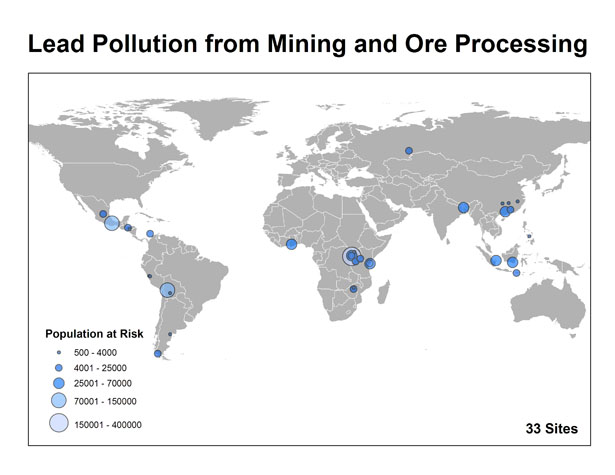
Populations estimates are preliminary and based on an ongoing global assessment of known polluted sites.
Industrial Process
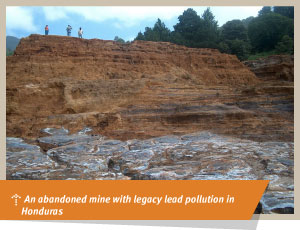 Mining can be an extremely destructive practice that often has very negative impacts on the surrounding environment. Because the material that is mined for is surrounded by other ore and rock, mining creates large amounts of mineral waste in the form of waste rock and tailings. Waste rock consists of all of the earth surrounding the ore that must be removed in order to access the desired minerals, metals, and gems. Tailings are the waste material from the ore processing phase, and often contain toxins left over from the ore separating process along with small amounts of heavy metals that were not fully removed.
Mining can be an extremely destructive practice that often has very negative impacts on the surrounding environment. Because the material that is mined for is surrounded by other ore and rock, mining creates large amounts of mineral waste in the form of waste rock and tailings. Waste rock consists of all of the earth surrounding the ore that must be removed in order to access the desired minerals, metals, and gems. Tailings are the waste material from the ore processing phase, and often contain toxins left over from the ore separating process along with small amounts of heavy metals that were not fully removed.
Lead is almost always contained in sulfide ores as galena, or lead sulfide45. Waste rock material from mines that contain metal sulfides can lead to sulfuric acid drainage when left out in the open air. Tailings also contain minerals and materials that can lead to dangerous runoff and water contamination when stored improperly. Some mine waste and tailing dump sites are structurally unsound and often overflow and break, allowing contaminants to spill out over the surrounding environment. In some cases, mines will have long pipes or waste canals that carry tailings to waterways for dumping.
Global Context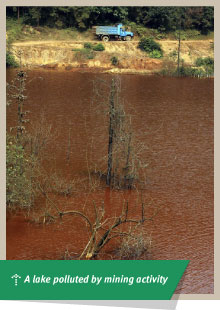
Lead is a heavy metal that occurs naturally in the earth’s crust, and it is mined for use in a variety of materials including paint, ceramics glaze, batteries, and pipes. Lead also commonly exists in ore containing other frequently mined materials, such as iron, copper, silver, and zinc. Thus, there are many different mining operations worldwide that could potentially be responsible for releasing lead into the environment.
Miners in regions that lack environmental, health, and safety standards are often ill-equipped for their work, and some do not wear gloves, or even shoes while handling material that may contain toxins. Some mines are built in very close proximity to villages and towns, and children may play on the waste rock or tailings. To date, Blacksmith has identified 36 sites where lead contamination from mining poses a serious health risk to over 1.2 million people, with populations in Africa and South America being the most impacted.

Exposure Pathways
Waste rock and tailings from mining and ore processing are not always stored or disposed of properly, and lead toxins in this material can leach into the soil and nearby water systems, impacting agriculture and water resources. In some cases, waste and tailings are dumped out in the open and near residential areas where people may come into contact with contaminants, or children may play near or on toxic material. Because lead can be absorbed through dermal and mouth contact, this form of exposure can be particularly dangerous for children.
Miners are also at risk of exposure if they do not have protective equipment and frequently come into direct contact with ore containing lead. Miners can also inhale lead as dust during the mining and crushing processes.
Health Effects
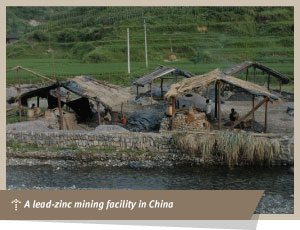
The health effects of exposure to lead can be both acute and chronic, and the problems caused by lead poisoning are particularly dangerous and severe for children. Acute lead poisoning can happen immediately and is often caused by inhaling large quantities of lead dust or fumes in the air. Chronic lead poisoning, however, occurs over longer periods of time and can result from very low-level, but constant, exposure to lead. Chronic poisoning is far more common than acute exposure and can be caused by persistent inhaling or ingestion of lead, or, over much longer periods, can result in lead accumulation in the bones.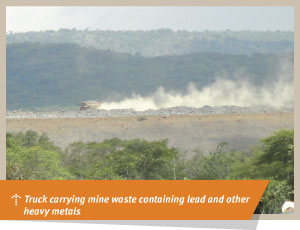 Health problems associated with lead poisoning can include reduced IQ, anemia, neurological damage, physical growth impairments, nerve disorders, pain and aching in muscles and bones, memory loss, kidney disorders, retardation, tiredness and headaches, and lead colic, which impacts the abdomen.19 Severe exposure to high concentrations of lead can lead to dire health risks, including seizures, delirium, coma, and in some cases, death.
Health problems associated with lead poisoning can include reduced IQ, anemia, neurological damage, physical growth impairments, nerve disorders, pain and aching in muscles and bones, memory loss, kidney disorders, retardation, tiredness and headaches, and lead colic, which impacts the abdomen.19 Severe exposure to high concentrations of lead can lead to dire health risks, including seizures, delirium, coma, and in some cases, death.
Neurological damage is especially pronounced in children suffering from lead exposure, with even small amounts of lead poisoning capable of causing lifelong developmental and cognitive problems. Exposure to lead in utero can also cause birth defects.
Example – DALY Calculations
A large mine on the island of Cebu in the Philippines was in operation from 1953 until 1994. When the mine closed, it left behind waste rock, tailings, open pits, and landfills that are leaching lead toxins into the environment. In 2006, mining operations re-commenced, and are also responsible for lead pollution in the area. Blacksmith samples found 18,194 parts per million of lead in river sediment. Blacksmith estimates that 3,500 people are impacted from disease caused by lead exposure.
DALYs associated with adverse health impacts from lead exposure at this site are estimated to be 74,624 for the estimated exposed population of 3,500. This means that the approximately 3,500 affected people will have a collective 74,624 years lost to death, or impacted by disease or disability. Distributed equally across the impacted population, this comes out to 21 years lost or lived with a disability per person.
Footnotes:
[19]: “New Basel guidelines to improve recycling of old batteries.” United Nations Environment Programme. May 22, 2002. Available at: http://www.unep.org/Documents.Multilingual/Default.asp?DocumentID=248&ArticleID=3069&I=en.
[45]: Brown, T.J., et al. “World Mineral Production 2003-2007.” British Geological Survey, 2009. Available at: http://nora.nerc.ac.uk/6251/.

-
Artisanal Gold Mining
Mercury Pollution
-
Industrial Estates
Lead Pollution
-
Agricultural Production
Pesticide Pollution
-
Lead Smelting
Lead Pollution
-
Tannery Operations
Chromium Pollution
-
Mining and Ore Processing
Mercury Pollution
-
Mining and Ore Processing
Lead Pollution
-
Lead-Acid Battery Recycling
Lead Pollution
-
Arsenic in Groundwater
Arsenic Pollution
-
Pesticide Manufacturing and Storage
Pesticide Pollution
-
The Rest of the Toxic Twenty



